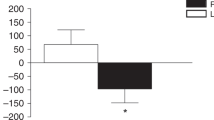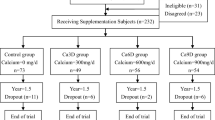Summary
Background Bone mineral density (BMD) is largely genetically determined and this influence is most powerful in the period of rapid skeletal development in childhood and late adolescence but environmental factors such as exercise and dietary calcium intake may influence up to 20%.
Aims of the study The aims of the study were to examine healthy late adolescent females for the effects and benefits of a high calcium intake from dairy product foods on bone mineral density, body composition, lipids and biochemistry. The secondary aim is determine whether a high intake of dairy product foods in the diet is acceptable for this age group long term.
Methods Ninety-one teenage girls who participated in a two-year randomised controlled study on the effect of dairy food supplementation on dietary patterns, body composition and bone density in post-pubertal teenage girls were approached one year after the cessation of the study to determine the effects of the cessation of dairy supplements on bone mineral density, dietary habits, biochemical markers, body composition and blood lipids. Bone mineral density and bone mineral content were assessed at the hip, spine and total body. Anthropometric data were collected, and exercise, Tanner, dietary assessment, preference and compliance questionnaires were administered. Lipid profiles, hydroxyproline excretion and urinary calcium and sodium excretion measurements were performed.
Results There were no significant differences between the 2 groups for height, weight, lean and fat mass.
The supplemented group had significantly higher calcium, phosphorus and protein intake during the supplementation period (p<0.001). No differences were seen between the groups 12 months after supplementation finished.
There were no significant differences in exercise level, preference or acceptability of dairy products or in the lipids and bone markers between baseline the end of supplementation and 1 year follow-up.
There was a significant increase in trochanter (4.6%), lumbar spine (1.5%) and femoral neck (4.8%) BMD (p<0.05) in the high calcium group at the end of supplementation. There was an increase in bone mineral content at the trochanter (p<0.05) and lumbar spine; however the latter was not statistically significant, in the high calcium group at the end of supplementation. There was no difference in vertebral height or width at any stage of the study, indicating no influence on bone size.
Conclusions In this 3 year study (2 years of supplementation, 1 year follow-up), teenage girls, aged 15–18 years, were able to significantly increase their BMD at the trochanter, femoral neck and lumbar spine when supplemented with dairy product foods to a mean calcium intake of 1160 mg/d. There was also an effect seen on the BMC particularly at the trochanter and to a lesser extent at the lumbar spine. The dietary calcium intake achieved did not adversely affect body weight, fat and lean mass or blood lipid profiles. Twelve months after the supplementation finished the girls had returned to their baseline diet, indicating self-selection of a high dairy product diet may be hard to achieve.
Similar content being viewed by others
Author information
Authors and Affiliations
Additional information
Received: 5 June 2000, Accepted: 5 September 2000
Rights and permissions
About this article
Cite this article
Merrilees, M., Smart, E., Gilchrist, N. et al. Effects of dairy food supplements on bone mineral density in teenage girls. Eur J Nutr 39, 256–262 (2000). https://doi.org/10.1007/s003940070004
Issue Date:
DOI: https://doi.org/10.1007/s003940070004




